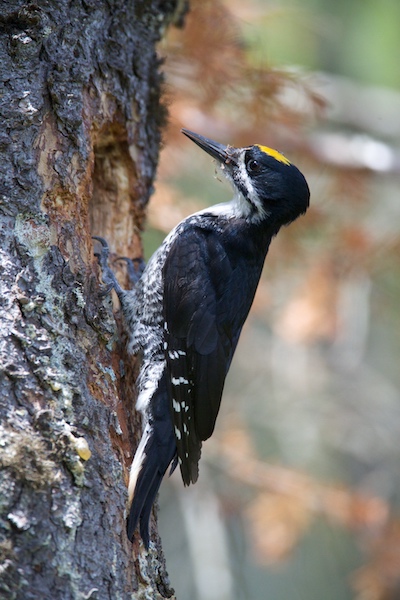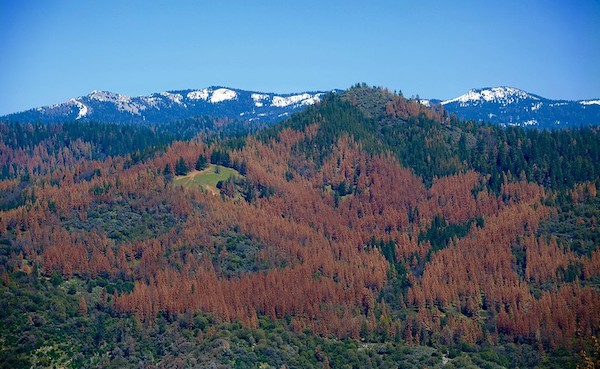Devastating fires in California dominate the headlines, but fire is not the only thing killing trees on a large scale in the state. Over the last decade a lethal combination of drought and bark beetles has also left swathes of snags, or dead trees, in its wake. This might seem like good news for species like the Black-backed Woodpecker which forages on and nests in snags. But from a woodpecker's point of view, is a snag killed by bark beetles the same as a snag killed by fire?
"Bark beetle outbreaks are a pretty novel phenomenon in the Sierra Nevada, at least at the scale we've been seeing in recent years. While you often hear of large patches of forest dying in the Rockies, the Sierras have largely escaped this problem," says Morgan Tingley, an ecologist at the University of Connecticut. "This new phenomenon presented an obvious question: 'Will woodpeckers use forest that has been killed by a disturbance other than fire?'”

A Black-backed Woodpecker visits its nest. Photo courtesy of USFWS.
In the most recent issue of Forest Ecology and Management, Tingley along with co-authors from The Institute for Bird Populations and the US Forest Service, explore this question. Specifically, they ask whether you find as many of these woodpeckers in beetle-killed stands as you do in burned stands. The study is part of a decade-long research program led by The Institute for Bird Populations to better understand the ecology of Black-backed Woodpeckers in California and how post-fire forest management affects them and other wildlife.
Over a period of 3 years, the researchers surveyed for Black-backed Woodpeckers throughout the bird's range in California. They covered 75 burned and 113 beetle-killed forest stands, using recordings of the woodpecker's calls and territorial hammering on tree trunks to elicit responses from this sometimes hard to detect species. All other factors being equal, they found that Black-backed Woodpeckers were 12.6 times more likely to be found in burned forest stands than stands killed by bark beetles.
"Our findings indicate that, for the most part, Black-backed Woodpeckers don’t colonize forests killed by drought and bark beetles to the same extent that they use burned forests," says Rodney Siegel, executive director of The Institute for Bird Populations and co-author of the paper. The researchers suspect that this has more to with another type of beetles–the woodboring beetles, which are much larger (and preferred by Black-backed Woodpeckers) than their bark beetle cousins. Siegel elaborates:
Hungry Black-backed Woodpeckers don’t really care about dead trees per se, they care about the woodboring beetle larvae that live inside the dead trees. Some groups of woodborers are able to rapidly colonize burned forests in large numbers because they can sense fire and smoke from far away. They lay eggs on the dead trees, which soon hatch and provide an all-you-can-eat buffet of super-abundant larvae for the woodpeckers. But without the cues of fire and smoke, forests killed more slowly by drought and bark beetles may not attract as many woodborers. And even where woodborers may be abundant in forests killed by bark beetles, Black-backed Woodpeckers may be less likely to look for them there, as large stands of beetle-killed trees were generally rare in California until very recently.
In other words, the woodpeckers may also look for burned trunks as a signal that food lies within. The researchers conclude that any benefit of beetle-killed forest stands to Black-backed Woodpeckers may lie more in their flammability than their immediate value as habitat. Bark beetle-killed trees are predisposed to burn, and once they do, the woodboring beetles and their numerous, tasty larvae may arrive.
But determining exactly how Black-backed Woodpeckers, and other snag-loving species use beetle-killed stands will take more research. "Beetle-killed forests present an unprecedented phenomenon in California that has suddenly covered a vast area. If this forest type is part of the 'new normal' of California's ecology, we need to know what potential role these forests will play in the overall ecology of the Sierra Nevada," says Tingley.






